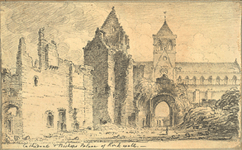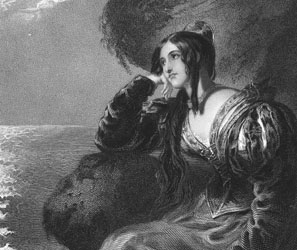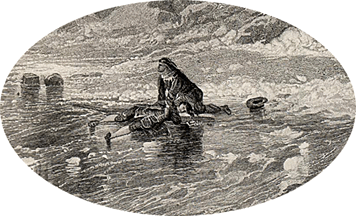|
|
Home | Corson Collection | Biography | Works | Image Collection | Recent Publications | Portraits | Correspondence | Forthcoming Events | Links | E-Texts | Contact The PirateFirst Edition, First Impression: The Pirate. By the Author of "Waverley, Kenilworth," &c. In Three Volumes. Vol. I (II-III). Edinburgh: Printed for Archibald Constable and Co. And Hurst, Robinson and Co., London, 1822. Composition | Sources | Synopsis | Reception | Links Composition
The composition of The Pirate was an uncharacteristically protracted affair. It was the only novel that Scott completed in 1821. He had written eleven novels in the previous seven years and would write six more in the next four. However, almost exactly a year passed between Constable's suggestion of title and subject-matter and the eventual publication of The Pirate in December 1822. Extra-literary engagements occupied Scott for much of 1821. He made two lengthy trips to London, first on legal business (January-April), and then to attend the coronation of George IV in July. During the summer, Scott was preoccupied by extensive building work at Abbotsford. He was further delayed by other literary commitments. In the course of the year, Scott published his Private Letters of the Seventeenth Century (an account of the early years of the reign of James VI and I), an edition of Richard Franck's Northern Memoirs, and, finally, an account of the life and works of Tobias Smollett for Ballantyne's Novelists' Library. The Novelists' Library, a series of economically priced reprints of popular novels and romances, was a project that John Ballantyne had long cherished. Sadly, he died in June 1821 after years of ill health. Scott saw through the publication of the series in memory of his dead friend, and provided biographical introductions to each volume. Scott was also hampered, however, by the sheer unfamiliarity of his subject matter. Unlike previous novels, The Pirate would be set in a region little known to him, and both plot and characters would owe relatively little to historical precedents. Scott began work on the novel by 18 or 19 April 1821, but took until 9 August to complete the first volume. His pace quickened once he was firmly established at Abbotsford in September. Here he received significant assistance from a house-guest, his old school-friend William Erskine. Erskine had been a fellow Commissioner on Scott's 1814 trip to the Northern Isles, and was now Sheriff of Orkney and Zetland (Shetland). He was thus able to supplement Scott's own recollections and research with first-hand knowledge of the region. The Pirate was finished in the second half of October and, following a delay at the printing office, was published in Edinburgh on 21 or 22 December and in London on 24 December. SourcesThe Pirate is set at the end of the seventeenth century, a few decades earlier than the real-life events (the exploits of John Gow), on which they are loosely based. The editors of the recent Edinburgh Edition of the novel, Mark Weinstein and Alison Lumsden, convincingly argue that the plot unfurls between July and August 1689, against the back-drop of the Glorious Revolution. By moving events further into the past, Scott was able to portray tension between the native Norse stock of the Northern Isles and the incoming Scots lairds (who had thoroughly imposed their language and customs by the days of John Gow). He is thus able to portray the old order succumbing to the new both locally and nationally. Scott's most important source was his own 'Diary' of the 1814 tour of the Western and Northern Isles as a Commissioners for the Northern Lighthouses (printed in Lockhart's Memoirs of the Life of Sir Walter Scott, Bart.). For information on Gow and pirate life, he drew on Captain Charles Johnson's A General History of the Robberies and Murders of the Most Notorious Pirates and the anonymous History and Lives of the Most Notorious Pirates and their Crews. He also received accounts of Gow from the historian Malcolm Laing, whose grandfather had helped capture Gow, and from Alexander Peterkin, Sheriff-Substitute of Orkney and Zetland. Perhaps, though, these sources proved less influential on the portrayal of Scott's pirate hero, Captain Cleveland, than on that of his villainous associate Captain Goffe. Cleveland himself is essentially a Byronic anti-hero. Scott also learned from his re-reading of Smollett's novels while working on the biography for Ballantyne's Novelists' Library. The depiction of life at sea in The Pirate draws, in particular, on Smollett's The Adventures of Peregrine Pickle.
SynopsisThe Pirate is set in a remote part of Shetland, where Basil Mertoun lives as a tenant of Magnus Troil. In his youth, Mertoun has been betrayed by a faithless wife, and in a spirit of vengeance, turned to piracy. Filled with remorse for his crimes, he lives as a recluse, along with his wife's son Mordaunt, whose paternity is doubtful. Bewildered by Mertoun's coldness, Mordaunt frequents the Troil household and becomes close to Magnus's daughters Minna and Brenda. Their tranquillity is interrupted by the arrival of the shipwrecked pirate Clement Cleveland, whom Mordaunt rescues from the waves but whose enmity he quickly arouses. Minna and Cleveland fall in love. Magnus Troil, crediting a malicious rumour that Mordaunt has boasted he can marry either of his daughters at will, banishes him from his society, and takes Cleveland into his home. Brenda does not believe the slander, and in Mordaunt's absence, realizes she loves him. Mordaunt is assisted against Cleveland by Ulla Troil, a relative of Magnus, known as Norna of the Fitful-head. Ulla, who lays claims to supernatural powers, believes that Mordaunt is her son by Mertoun who had seduced her during an earlier visit to the island. She wishes to see Mertoun married to Minna and resolves to distance Cleveland at all costs. Minna is horrified when Cleveland open-heartedly confesses to her that he is a pirate. Hearing that his former colleagues are moored at Kirkwall, Cleveland sets out for Orkney with the purpose of disassociating himself from them. He is compelled, though, to rejoin them against his own wishes and subsequently captured by government forces acting on information supplied by Ulla. Cleveland is wrongly believed to have killed Mordaunt in a fight before leaving Shetland, and the conscience-stricken Minna contracts a wasting disease. Ulla, invoking her prophetic powers, persuades the Trolls that she can only be cured by visiting Kirkwall Cathedral. En route to Orkney, they are captured by another band of pirates, and such is their brutality that Minna vows that she could never marry one of their kind. They are rescued by Mordaunt who has merely been wounded by Cleveland, and the grateful Magnus consents to his marriage with Brenda. Having engineered Cleveland's capture, Ulla discovers that he, not Mordaunt, is her son by Mertoun. In remorse, Ulla renounces her role as prophetess and devotes herself to the study of the Bible. Cleveland is pardoned in view of past acts of humanity, and joins the navy. Mertoun retires to a foreign monastery; Minna remains unmarried. ReceptionCritical reaction to The Pirate was highly polarized. Lavish praise came from the Scotsman and from Blackwood's, for whom Scott was 'one of the greatest of all national historians'. Also favourable were the Edinburgh Magazine, extolling the 'gigantic, versatile and prolific powers of this matchless Delineator of Nature', and the New Edinburgh Review which judged the novel 'equal to any of the collection in the varied talent and power which distinguish them all'. The former, however, regretted the overlengthy descriptions of Shetlandic localities and customs, and the latter found the plot highly improbable. These criticisms were amplified in the hostile notices that appeared in The Gentleman's Chronicle, Literary Chronicle, and Examiner, which suggested that The Pirate worked better as an essay on Shetlandic manners than as a piece of fiction. Despite these critical reservations, The Pirate was an immediate success and remained one of Scott's most popular and most reprinted works throughout the nineteenth century.
LinksLast
updated: 19-Dec-2011 |
|

 Having suggested both title and subject-matter for
Having suggested both title and subject-matter for 
